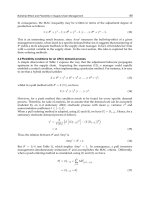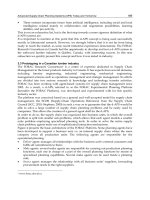Risk Management in Environment Production and Economy Part 1 doc
Bạn đang xem bản rút gọn của tài liệu. Xem và tải ngay bản đầy đủ của tài liệu tại đây (780.62 KB, 20 trang )
RISK MANAGEMENT
IN ENVIRONMENT,
PRODUCTION
AND ECONOMY
Edited by Matteo Mario Savino
Risk Management in Environment, Production and Economy
Edited by Matteo Mario Savino
Published by InTech
Janeza Trdine 9, 51000 Rijeka, Croatia
Copyright © 2011 InTech
All chapters are Open Access articles distributed under the Creative Commons
Non Commercial Share Alike Attribution 3.0 license, which permits to copy,
distribute, transmit, and adapt the work in any medium, so long as the original
work is properly cited. After this work has been published by InTech, authors
have the right to republish it, in whole or part, in any publication of which they
are the author, and to make other personal use of the work. Any republication,
referencing or personal use of the work must explicitly identify the original source.
Statements and opinions expressed in the chapters are these of the individual contributors
and not necessarily those of the editors or publisher. No responsibility is accepted
for the accuracy of information contained in the published articles. The publisher
assumes no responsibility for any damage or injury to persons or property arising out
of the use of any materials, instructions, methods or ideas contained in the book.
Publishing Process Manager Ana Pantar
Technical Editor Teodora Smiljanic
Cover Designer Jan Hyrat
Image Copyright Tatiana Popova, 2010. Used under license from Shutterstock.com
First published September, 2011
Printed in Croatia
A free online edition of this book is available at www.intechopen.com
Additional hard copies can be obtained from
Risk Management in Environment, Production and Economy,
Edited by Matteo Mario Savino
p. cm.
978-953-307-313-2
free online editions of InTech
Books and Journals can be found at
www.intechopen.com
Contents
Preface IX
Part 1 Environment 1
Chapter 1 Coastal Risk Management Modes: The Managed
Realignment as a Risk Conception More Integrated 3
Hugues Heurtefeux, Paul Sauboua,
Provence Lanzellotti and Amandine Bichot
Chapter 2 Toward a Hydro-Economic Approach
for Risk Assessment and Mitigation
Planning of Water Disasters in Semi-Arid Kenya 27
Cush Ngonzo Luwesi, Chris Allan Shisanya
and Joy Apiyo Obando
Chapter 3 Generation of Added Values
Products Supporting Risk Analysis 47
Massimo Musacchio, Malvina Silvestri, Luca Merucci,
Stefano Corradini, Claudia Spinetti, Valerio Lombardo,
Boris Behncke,Lorenzo Guerrieri, Gabriele Gangale,
Fabrizia Buongiorno, Sergio Perelli, Sergio Teggi,
Sergio Pugnaghi, Angelo Amodio, Eugenio Sansosti,
Simona Zoffoli and Chiara Cardaci
Part 2 Production 75
Chapter 4 Food Safety Risk Management 77
Elena Carrasco, Antonio Valero,Fernando Pérez-Rodríguez,
Rosa María García-Gimeno and Gonzalo Zurera
Chapter 5 Risk Analysis in the Mining Industry 103
Undram Chinbat
Chapter 6 A Fuzzy Comprehensive Approach for Risk Identification
and Prioritization Simultaneously in EPC Projects 123
R. Tavakkoli-Moghaddam, S.M. Mousavi and H. Hashemi
VI Contents
Part 3 Economy 147
Chapter 7 A Comprehensive Risk Management
Framework for Approaching the
Return on Security Investment (ROSI) 149
Elvis Pontes, Adilson E. Guelfi, Anderson A. A. Silva
and Sérgio T. Kofuji
Chapter 8 Market Risk Management
with Stochastic Volatility Models 171
Per Solibakke
Preface
Risk management is nowadays the way to prevent serious damage or critical
consequences from dangerous situations in everyday life. Although, for many years,
much has been done in terms of prevention and great efforts are continuously
invested into it, the concept of risk as an unforeseen event which can cause danger
or a great modification of a previous situation is still an issue to be taken into
account.
Even if the term “risk” is often negative in its common acceptation, many opportunities
can arise from such a situation: not only speculation but, above all, the possibility to be
prepared to tackle the events and to use the mind in order to develop new solutions
which can convert a possible danger to an unforeseen but positive event.
Unforeseen events are very common not only in natural phenomena but also in human
activities: volcanoes, coasts and natural environment rather than projects, food safety,
mining and construction industry are examples of the possible application fields of
risk management analysis.
This book presents a structured collection of papers dealing with the subject and
stressing the importance of an issue such as risk management. The aim is to present
the problem in various fields of application of risk management theories, highlighting
the approaches which can be found in literature.
The book is organized in three macro parts and their respective chapters referring to
three macro areas which can be involved in the risk management analysis.
The first part of the book analyzes risk management methodologies with respect to the
environment by introducing approaches to prevent volcano disaster, water disaster or
coastal degradation through three representative case studies.
The second part deals with the production field and introduces peculiarities in project
management process, food chain and some sectors of industry through the use of new
techniques combined with risk analysis.
X Preface
The last part discusses the application of risk management in economic sector to face
the dynamicity and unforeseen events which can arise and, thus, better understand
and tackle the actual global economy.
Prof. Matteo Mario Savino,
Dept. of Engineering, University of Sannio, Italy
Part 1
Environment
1
Coastal Risk Management Modes:
The Managed Realignment as a Risk
Conception More Integrated
Hugues Heurtefeux, Paul Sauboua,
Provence Lanzellotti and Amandine Bichot
EID Méditerranée, Montpellier,
France
1. Introduction
Land managers assess the risk by evaluating the probability of hazard occurring and likely
damage that would occur to economic assets. There are two types of hazards. The first is
caused by wave action, near-shore current and wind effects; which imply erosion and its
associated risk of flooding. The second is increased by physical structures that have been
built with the aim of protecting the coastline. Storms can induce the destruction of coastal
protections as dunes and promote the sea submersion. Sea submersion is a temporary flood
of coastal area due to the sea and needing extreme weather conditions. Given the
importance of biodiversity and attractive nature of coastal areas, they present different
stakes. There are socio-economic stakes as people, amenities, activities and infrastructures.
And in the same way, there are natural stakes and cultural heritages as natural areas and
historic building.
To anticipate coastal risks, coastal management has always been a major question for land
managers. During the XIX
th
century, Victor Hugo himself has made speeches to outline the
vulnerability of coastal areas to these hazards (Hugo, 1846). For a long time, hard structures
were built to hold the line and to provide high level of protection to population. These
options more easy to develop were usually used because of absence of knowledge. But in
the last twenty years, new approaches to manage coast have been developed.
This shift of coastal management by the decision makers has depended on the appearance of
the Integrated Coastal Zone Management (ICZM) concept too. The ICZM is originating from
the US and adapted in France via Europe. It replaces a protectionist policy, long based on a
naturalistic approach. Taking consideration of the economic, sociological, biological
concerns and the democratic, educational and political ones as well, with in addition the
relationships between the various partners involved, is a land management way that cannot
be ignored these days of sustainable development (Bawedin, 2009).
One of these new approaches to manage coastal areas corresponds to the managed
realignment (MR). Different cases of managed realignment exist and constitute a
heterogeneous set. Indeed local context differences as the type and the importance of stakes
and hazards, of sites topography, but especially of coastal management conceptions into
public policies, induce an important diversity of M.R. cases. Thus in a context of thoughts
Risk Management in Environment, Production and Economy
4
about management modes to use into coastal areas, it seems necessary to analyse this
emerging notion. This publication will permit to study in a first part (i) the M.R. notion, and
the objectives and actions to which they correspond to. Overviews in a second part will
permit to evaluate in France (ii) a case where MR seems to be a pertinent option and an
other (iii) where MR option has been set up.
2. Emergence of a coast management mode, the managed realignment (M.R.)
Land managers have always tried to limit the risks resulting to the interaction between
present coastal stakes as population, housing and infrastructures presence, with coastal
hazards. This objective has sometimes implicated the obligation to shift some of these stakes
because of the evolution of extreme events in their intensity or frequency. Some old
marginal cases existed like the Brighton Beach Hotel at Coney Island (New York, United
States) which has been shifted during the XIX
th
century of about 180 meters because of
storm wave action (Trevi, 2008). But the majority of M.R. cases are quite recent. The reality
proved than for a long time hard structures like seawalls, embankments, groynes,
breakwaters were built to hold the line and to provide high level of protection to
population. These options more easy to develop were usually used because of absence of
knowledge (no strong computers for efficient numerical models, no climate change context)
and cultural attitude (coastal lands loss was difficult to accept, whereas dykes increase
safety sentiment). In the last twenty years, four global approaches to manage coast have
been developed (cf. figure 1):
The approach by holding the line, as presented above, has persisted to be used.
Traditionally, the goal is to protect developed area using hard structures (Klein and al.,
2001).
The “do the minimum” approach. It corresponds to the use of natural processes to
reduce risks but permitting coast natural changes. Some of the techniques used with
this approach attempt to limit rather than to stop coastal erosion and cliff’s retreat;
The “do nothing“ approach, which is rare but can be found. One of the more famous
cases of “do nothing” approach is the municipality of Happisburg, in the county of
North Norfolk (UK). The storm waves reached the coast with important damages on the
bottom of the cliff, the cliff fell with mayor impact on the houses totally destroyed (cf.
figure 2). Do nothing is one of policies adopted when it’s too late, when any decision
has been thought before, when the cost benefit analysis shows than the defence front to
the sea exceeds the value of the properties.
The M.R. approach which is quite recent. Its definitions and its particularities will be
presented below.
Climate change would tend to modify coastal hazards. Thus as the 4
th
evaluation report of
the Intergovernmental Panel on Climate Change (IPCC), means sea level will have for the
2090-2099 decade a rise inclusive between 0,18 and 0,59 m in comparison to the 1980-1999
period (IPCC, 2007). In the same way, as the report of the National Observatory on Climate
Change effects, Climate change is happening with several effects directly observed on the
coast (ONERC, 2007) :
Sea level rise,
Growing of damage by river and sea floods on the coast,
Trend of more storms but not totally confirmed.
Coastal Risk Management Modes:
The Managed Realignment as a Risks Conception More Integrated
5
Fig. 1. Policy options for coastal management (European Commission, 2004)
This coastal evolution has an impact on coastal management. In the recent past; land
managers were using a different approach in which properties were not moved but instead,
protected by hard structures. The use of this holding the line approach has started to be
criticized. It has some economic drawbacks (high construction and maintenance costs),
environmental drawbacks (breaking of the natural dynamic of the longshore current into the
sea sediment cell) and spoils the landscape. Moreover this management mode can be
especially questionable into the reasoning. The focus is on the problem of sediment flows
rather than on their causes (EID-med, 2010).
An analysis of advantages and disadvantages of the classical management approaches and
the evolution of natural hazards have led to a reassessment of these conventional
management methods. Thus due to this reassessment, managed realignment projects have
been implemented quite recently. One of the oldest (1987) realignments in Europe is
Beltringharder Koog, state of Schleswig Holstein, Germany. To compensate for the adverse
effects caused by a new polder (land reclamation) built in the Nordstrand Bay, a salt water
lagoon and an intertidal habitat were created with a surface area about 1 000 ha (ABPmer).
M.R. needs political support to make the public aware of the benefits of this approach.
That’s why this concept has for a long time been difficult to implement
1.1 Different coastal areas management policies represented by a set of definitions
For a long time managed realignment used to be called managed retreat. That was the case
in England for example. This term has gone out of favour, since it implies negativity in
coastal management, and a “retreat in the face of the enemy”, rather than a rational
management choice (Rupp and Nicholls, 2002). For the British Government, the M.R. of
coasts and rivers is defined as a process of establishing a new flood defence line for river
Risk Management in Environment, Production and Economy
6
corridors or coastlines often set back from the existing position, with the aim of improving
the long-term sustainability of the defence, or contributing to other aims such as habitat
creation (DEFRA, 2005). For Laure Ledoux (Ledoux, 2005), this definition must be
understood as the definition of a new defence line, on the coast line but into the estuaries
and bank rivers too. So it is in question of a voluntary approach and pro-active, in
opposition to “inactive realignment” limited to not look after existing defences. M.R.
objectives are numerous. It permits so a diminution of defences costs by the reduction of
structures dimensions, and the increase of defences effectiveness and durability due to
wave’s energy absorbed by the wetlands created. There is an ecosystems creation or
restoration too, with sometimes for specific objective to satisfy biodiversity protection
criterions as defined by European directive on habitats. Another objective, in the particular
case of estuaries, can be the obtaining of a more stable form face to the sea level rise, or to
have an influence on sea level and flood risk.
M.R. consists generally in the artificial creation of a breach in existing structures (Dickie,
2010) (cf. figure 3). It permits to water to flood until the next natural relief or the new
defence line constructed more into the hinterland. In this case, M.R. is more corresponding
to a process of depolderisation. Indeed Western Europe’s depolderisation was launched in
the 1980’s. A lot of different cases exist in United Kingdom where precisely management
policies are directed towards M.R. (Goeldner-Gianella, 2007).
-1992-
-1999-
Fig. 2. Case of "do nothing" approach in Happisburgh (UK) (Coastal Concern Action Group)
Coastal Risk Management Modes:
The Managed Realignment as a Risks Conception More Integrated
7
Fig. 3. Representation of strategic realignment (Rupp and Nicholls, 2002)
Since 2005 the management of risks in United Kingdom is concerned by a new strategy
called “Making space for water”. The main goal of this strategy is to consider environmental
and social aspects of floods and coastal protection. It will put forward adaptation
recommendations to climate change and promote managed realignment. This strategy
includes the recognition of socio-economic, tourist and environmental factors in their
totality, the improvement of knowledge relative to hazards, cooperation between
stakeholders, development of innovative solutions and the consideration of these risks into
land management plans. The same consideration of social, economic and environmental
aspects is taken into account in area of flood management in Belgium. In that way, Belgium
is a partner with United Kingdom of the project European Spatial Planning: Adapting to
Climate Events.
Managed realignment is used in United States too. It is defined in the same way as in United
Kingdom but it implies the abandon, the destruction, or the construction shifting on sectors
potentially liable to flooding (SFP and URA). In United States, managed realignment is
favoured by goods relocation aid and buy-back programs. These programs can be used to
promote managed realignment and avoid complaints from sectors where an unconstructible
area has been defined. With this coastal management approach, indemnification and
relocation possibilities are taken into account.
In France, it is underlined that the process of realignment consists in a switch as a straight
line. Thus there is a disappearance of uncertainties areas that make the richness of coastal
environments (Léger, 2005). So the term of hindsight is more used in France. It is defined as
a backward step or movement. This distant position into the space or into the time permits a
better vision and assessment. Hindsight management objective is rather to move back
present stakes on the coast towards the hinterland. That corresponds to an integrated
management policy.
Risk Management in Environment, Production and Economy
8
Another type of term is used. In Canada retreat is more used to define the shunning of the
risk: retreat or shunning consists in avoiding risks so as to eliminate direct impacts. Instead
of attempt to protect land against sea encroachment, we give up to development project and
we choose rather to abandon threatened land when conditions become intolerable. For
example, it is possible to resort to a dissuasive regulation to reduce losses due to erosion. In
some cases, restoration can be an alternative solution profitable for coastal constructions.
Retreat corresponds to a proactive adaptation form to eliminate a direct impact. Easier
retreat form consists in avoiding to buy vulnerable estates, in the case of individual buyers,
or to construct in areas with a flood or erosion risk (Canadian Government, 2004).
By this process, the objective is rather to avoid the creation of new coastal stakes than to
remove already existing ones. Finally coast line will be abandoned especially if natural
hazards are strong but it is not a shifting policy strictly speaking.
The analysis of the different used terms indicates that these differences could be explained
in a first part by a difference between expected objectives. These objectives would be to
move back the stakes present on the coast to the hinterland, to create a new defence line
backwards facing the sea to restore natural areas and a buffer space between sea and stakes,
and to avoid the addition of new stakes at existing ones into coastal areas (cf. figure 4). It
appears in a second part that these terms aren’t used in the same countries. It could be the
expression of the existing heterogeneity between countries with coastal line about their
strategic orientations of coastal management.
Fig. 4. Strategies diversity linked to managed realignment
1.2 Overviewes of managed realignement use in the french context
1.2.1 To the European scale
Managed realignment is discussed by European Commission in order to respond to
increasing coastal risks and climate change (European Commission, 2007). Coastal
development and management have to be tackle in a strategic, coherent and integrated way.
A guide about European Union action in view of climate change has been published in 2008
(European Commission, 2008). Nevertheless these recommendations are more based on the
struggle of climate change than on the thorough adaptations. Erosion and marine
submersion are analysed only with an economic and speed of execution points of view.
Thus M.R. isn’t really promoted into this report.
MANAGED REALIGNMENT
Why ?
To limit risks and thus hazardous areas by adaptation to consequences of climate
change
To move back the stakes
present on the coast to
the hinterland (integrated
management policy)
To avoid the addition of
new stakes at existing
ones into coastal areas
(progressive
abandonment)
To create a new defence line
backwards facing the sea to restore
natural areas and a buffer space
between sea and stakes
(depolderization: loss of land
reclaimed from the sea
)









